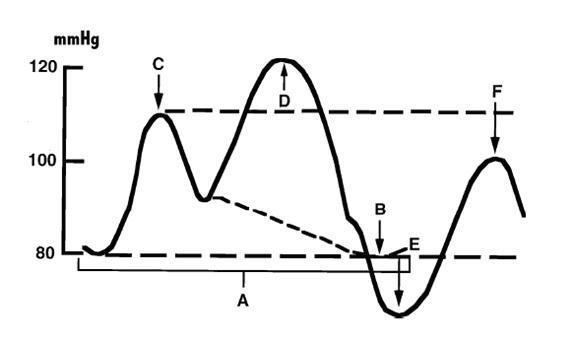 | ||
The Intra-aortic balloon pump (IABP) is a mechanical device that increases myocardial oxygen perfusion while at the same time increasing cardiac output. Increasing cardiac output increases coronary blood flow and therefore myocardial oxygen delivery. It consists of a cylindrical polyethylene balloon that sits in the aorta, approximately 2 centimeters (0.79 in) from the left subclavian artery and counterpulsates. That is, it actively deflates in systole, increasing forward blood flow by reducing afterload through a vacuum effect. It actively inflates in diastole, increasing blood flow to the coronary arteries via retrograde flow. These actions combine to decrease myocardial oxygen demand and increase myocardial oxygen supply.
Contents
A computer-controlled mechanism inflates the balloon with helium from a cylinder during diastole, usually linked to either an electrocardiogram (ECG) or a pressure transducer at the distal tip of the catheter; some IABPs, such as the Datascope System 98XT, allow asynchronous counterpulsation at a set rate, though this setting is rarely used. Helium is used because its low viscosity allows it to travel quickly through the long connecting tubes, and has a lower risk than air of causing an embolism should the balloon rupture.
Indications
The following situations may benefit from this device.
Absolute contraindication
The following conditions will always exclude patients for treatment:
Relative contraindication
The following conditions make IABP therapy inadvisable except under pressing circumstances:
Complications
Since the device is placed in the femoral artery and aorta it could provoke ischemia, and compartment syndrome. The leg is at highest risk of becoming ischemic if the femoral artery it is supplied by becomes obstructed. Placing the balloon too distal from the aortic arch may induce occlusion of the renal artery and subsequent kidney failure. Other possible complications are cerebral embolism during insertion, infection, dissection of the aorta or iliac artery, perforation of the artery and bleeding in the mediastinum. Mechanical failure of the balloon itself is also a risk which entails vascular surgery to remove under that circumstance. After balloon removal there is also a risk of 'embolic shower' from micro clots that have formed on the surface of the balloon, and can lead to peripheral thrombosis, myocardial ischemia, hemodynamic decompensation, and late pseudoaneurysm.
History
The IABP device was pioneered at Grace Sinai Hospital in Detroit during the early 1960s by Dr. Adrian Kantrowitz and his team-Bjørnstad PG, Lindberg HL, Smevik B, Rian R, Sørland SJ, Tjønneland S (1990).
The first publication of intra-aortic balloon counter-pulsation appeared in the American Heart Journal of May 1962; 63: 669-675 by S. Moulopoulos, S. Topaz and W. Kolff.
The device and the balloons were then developed for commercial use between 1967 and 1969 heart surgery by William Rassman, M.D. at Cornell Medical Center and were manufactured by Datascope Corporation in 1969. The system was subsequently used clinically by Dr. David Bregman in 1976 at NewYork-Presbyterian Hospital in New York City.
The first clinical implant was performed at Maimonides Medical Center, Brooklyn, N.Y. in Oct., 1967. The patient, a 48-year-old woman, was in cardiogenic shock and unresponsive to traditional therapy. An IABP was inserted by a cut down on the left femoral artery. Pumping was performed for approximately 6 hours. Shock reversed and the patient was discharged.
The size of the original balloon was 15 French but eventually 9 and 8 French balloons were developed. A second operation removed the balloon. Since 1979 the placement of the balloon has been modified using the Seldinger technique.
